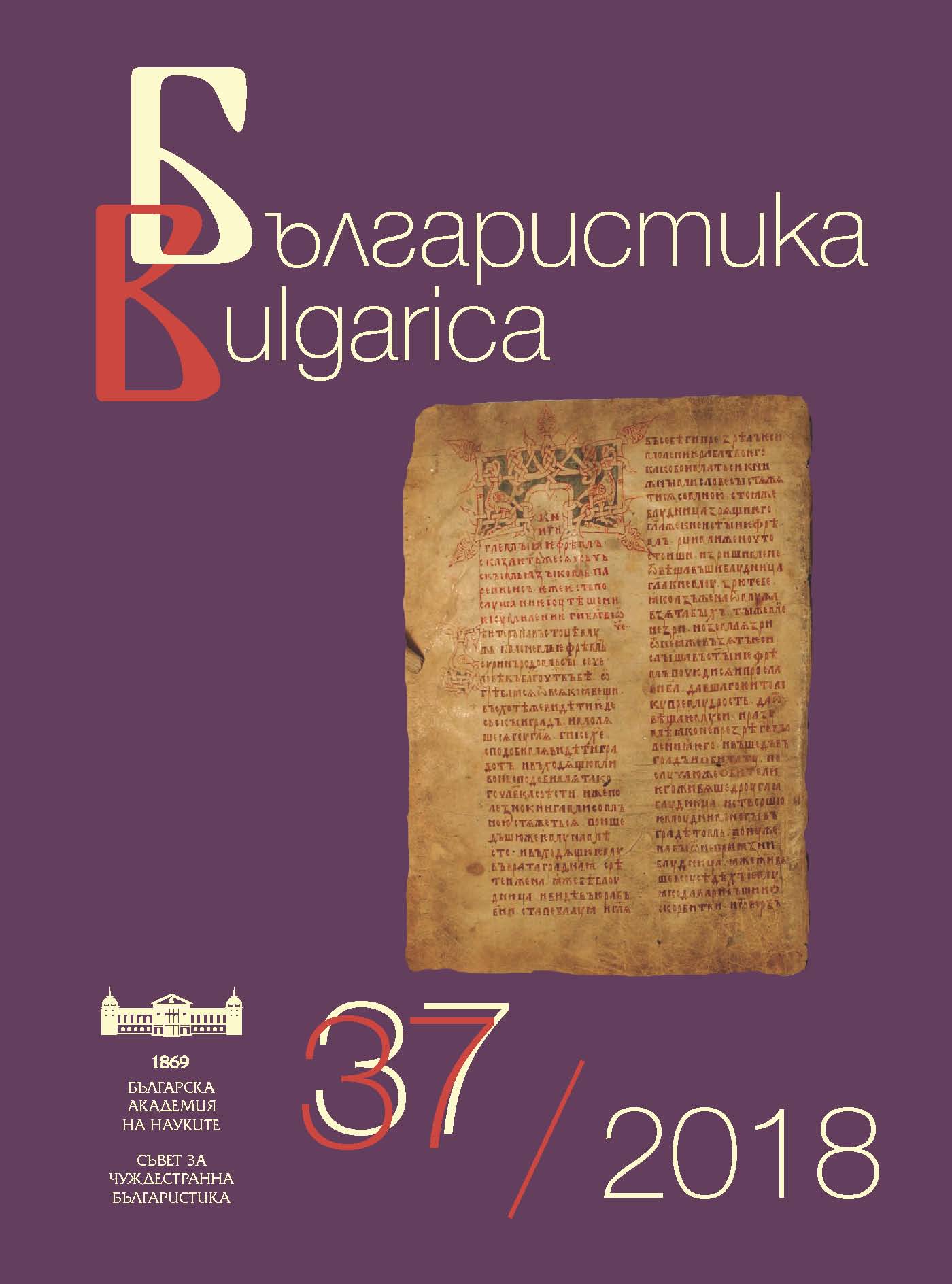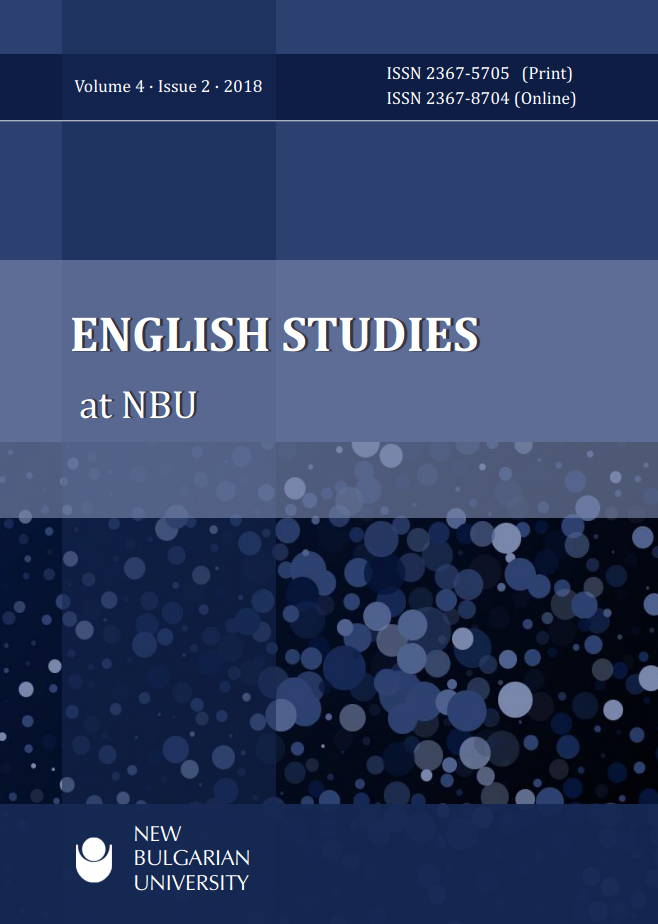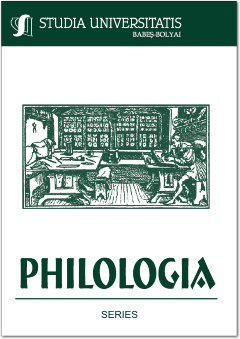
We kindly inform you that, as long as the subject affiliation of our 300.000+ articles is in progress, you might get unsufficient or no results on your third level or second level search. In this case, please broaden your search criteria.


The article discusses the current state of sign language interpreting in Bulgaria. It analyzes a range of historical, social and professional issues regarding policy-making, sign language education and methodology. Presented here are three interrelated factors influencing the interpreting practice in the country such as limited knowledge about the linguistic status of Bulgarian Sign Language, traditions in Bulgarian deaf education and social attitude of the hearing majority regarding the linguistic skills of deaf and hard-of-hearing people.
More...
My Cleaner: Help or Foe? Maggie Gee’s My Cleaner tackles the problem of racism and family life in the lives of two women who intend to support or “help” each other and end up bringing out the worst in each other. Profound racism and an acute sense of class difference alienate the two women: Vanessa Henman and Mary Tendo, her cleaner from Uganda. The theoretical background of the paper is offered by the theories of Paul Gilroy.
More...
A Tribute to Theodore Roszak. The Making of a Counterculture. The American professor Theodore Roszak (1933 – 2011) is generally credited with the invention of the term “counterculture”, although his seminal book from 1969, The Making of a Counter Culture spells the two words separately. To us, today it seems to be the work of a rather cautious, but pioneering sociologist, who acknowledges indeed the legitimacy of the student revolts of the Sixties but at the same time tries to distance himself from their heat with the cool objectivity of the academic observer.
More...
Flicker. Theodore Roszak’s sophisticated and extreme long novel Flicker, published in 1991, resonates in many ways with the masterpieces of the cryptographic thriller tradition, like Umberto Eco’s Il nome della rosa (1980) or Dan Brown’s Da Vinci Code (2003). Its core lies in the conspiracy theories, due a fictional plot driven from the deep shadows of the world of cinematography. By doing some research, a UCLA film scholar comes across the films made by a rather allusive American director protected by a secret organization. The director’s hidden biography takes us back to the interwar Germany, making the scholar to discover that his subject’s films contain hidden messages that can be deciphered by means of a special device.
More...
“We Stopped Dreaming”: Julie Otsuka’s (Un)Told Stories of Picture Brides. Focusing on Julie Otsuka’s acclaimed 2011 novel, The Buddha in the Attic, this paper will investigate the picture bride phenomenon as a multilayered trade of lives, identities, emotions and expectations, drawing a vivid picture of the protagonists’ subjection to exploitation, abuse, discrimination and deceit.
More...
Humour Mechanisms in Translation P.G. Wodehouse into Romanian. The aim of the present study is to analyse the Romanian translation of several instances of Wodehousian humour from the novels Thank You, Jeeves and Right Ho, Jeeves. We shall point to the humour mechanisms that may lead to the untranslatability of humour and to its being lost or destroyed during the translation process. However, this apparent untranslatability is not insurmountable, and humour can actually travel safely around the world.
More...
Representations of Black Masculinity in the 2010s Hip-Hop. One of the most well-known perceptions of contemporary African-American males comes from hip-hop music, a genre dominated largely by Black men. The overly sexual, hypermasculine, angry and aggressive persona is a characteristic of these performers. However, in recent years, this toxic masculinity has been challenged and deconstructed by mainstream artists. Important voices in hip-hop, such as Kendrick Lamar, Kanye West and Jay-Z are embracing a more truthful and intellectual approach to what it means to be a Black man in the United States. This paper sets out to explore these changes, exemplifying them through the lyrics of commercially successful and critically acclaimed rappers.
More...
Herman Melville’s Benito Cereno and the Subversion of the Slavery Ideology. The current paper aims to analyse in Herman Melville’s novella the interplay between the ambiguous narrative voice limited by Amasa Delano’s racially charged perception of events and the auctorial presence in the text. We argue that in Benito Cereno, the writer has constructed a symbolically charged but carefully targeted criticism against the social and moral failure of the slavery system in the U.S.
More...
Between Law and Custom: A View of the Racial Relationships in Charles Waddell’s Chesnutt’s “The House behind the Cedars”. The aim of this paper is to investigate the manner in which Charles Waddell Chesnutt skillfully uses the conventions of the sentimental novel and of the tragic mulatto/a character, familiar to his white readers, in order to dismantle racial preconceptions and expose the terrible ramifications of racism. The novel The House behind the Cedars shows that race is artificially constructed out of various external markers such as custom, law, dubious scientific findings, which, however, can have dire consequences for the individuals who need to obey such limitations.
More...
“The Outlook That Would Be Right.” Wallace Stevens’s Cinematic Vision. Drawing on the premise that a fundamental characteristic of modernist art is the convergence of various expressive and technical modes, this paper provides an examination of a selection of texts by Wallace Stevens in which the poetic vision and method intersect with the principles of cinematic montage, with a view to demonstrating the persistence throughout his oeuvre of a particular form of “sight”, employed for tackling a series of epistemological and aesthetic issues.
More...
Jennifer Egan’s A Vision from the Good Squad: A Narrative of Health, Disease and Death. This paper analyzes Jennifer Egan’s novel/ short story cycle entitled A Visit from the Goon Squad, winner of the 2011 Pulitzer Prize for fiction. The chapters/stories shift back and forth in time, moving from the late sixties to the present day and into the near future. The Proustian influence is obvious in this fascinating narrative of the self, the ailing body, and finally death. The interesting structure of the book, due to the influence of the TV series and the power point slides, adds a fascinating quality to this text which is the result of a vision that has all the characteristics of the contemporary age.
More...
Queering the Fairy-Tale in Anne Sexton’s Transformations. The current paper explores Anne Sexton’s volume of poetry, Transformations (1971), from a queer, feminist perspective. Each of the seventeen poems offers a distorted retelling of a Brothers Grimm fairy-tale, often replete with pop culture references and black humor. The paper examines the strategies of queering that the poet employs in her deconstruction of myths, storytelling, family relations (such as motherhood and fatherhood), gender roles, deformity and disability, and many other difficult subjects. The author makes use of feminist and queer theory, while also casting light upon the construct of the fairy-tale and why it offers a space for queer exploration. The fairy-tale allows the poet to examine aspects of trauma and intimacy at a remove, but with a view towards catharsis.
More...
The Truth from Fact to Fiction in Two Short Stories of the Twentieth Century Old South. The short-stories I have chosen to discuss here are “A Worn Path” (1941) by Eudora Welty and “The Artificial Nigger” (1955) by Flannery O’Connor. They are complementary – as I hope to prove – illustrating two versions of a one-(grand)parent family tale. The white grandfather in O’Connor’s story and the black grandmother in Welty’s story have to cope with ever more difficult tasks in terms of truth(telling/teaching) and (self-)discovery. For truth – at least personally, if not philosophically – may mean facing all dangers as an ancient grandmother, for the sake of her sick grandson; it can mean coming to terms with one’s own old self – in both stories; it may mean facing qualms of conscience and merciless loneliness – for both young and old.
More...
Jeanette Winterson’s The Stone Gods as an Ebullition of Genres. This article examines, through the lenses of genre theory applied to The Stone Gods, the reasons why the novel has been harshly criticised for failing to satisfy as science fiction. The analysis does justice to the novel’s complexity, revealing its multifarious nature, an example of the ebullition of literary genres that characterises many modernist and post-modernist works.
More...
Representations of War and Trauma in Pat Barker’s Regeneration. The Regeneration Trilogy focuses on the British soldiers of the Great War who, besides their physical wounds, often suffered from psychic and psychosomatic disorders, more or less disabling. The aim of this article is to discuss how trauma generated neurological and psychic disorders and affected the lives of soldiers, how the doctors of the time attempted to cure them and make them able to return to the frontlines. The article refers mostly to Regeneration, the first novel in the sequence.
More...
Sense of Place and Belonging in Sorley MacLean’s Poetry. Placing himself in the wake of Hugh MacDiarmid’s Scottish Renaissance, Sorley MacLean initiated the Gaelic Renaissance with the same aim in view. He turned to the Scottish impressive landscape as to a rich provider of metaphorical images that spoke of tradition, continuity and national consciousness.
More...
Dora D’istria: Mapping the Cultural Transfer of Intimacy at the “Fringes” of Europe. The present paper examines two texts by Dora D’Istria dealing with women’s emancipation and empowerment in the mid-nineteenth century. Thus, we shall analyze how women situated their experience against the discourses that regulated intimacy in the context of nation-building in that respective period.
More...
Communication Event. In Information and Communication Sciences, the phrase “communication event” is not clearly defined. We situate the notion of communication event in a space where the actors, whether human or non-human, equally participate in the event through the use of language. A communication event is the effect of preliminary staging. In this article we study the notion of communication event exploring three films of the same film maker, each of them creating an event within an event.
More...
A Stylistics of Exiled Lives. The article explores the correspondence between the particular stylistics of exiled lives (specific ways, manners, and forms of living developed during exile) and a specific critical method (para-biography). While all exiles can be perceived as people with underachieved destinies - exile is, in this case, comparable to premature death, lost works, imperfect style, sterility, etc. - the biographer who endeavors to “capture” the ways of the exiled should rely on a critical faculty fit to such uncompletedness, yet a faculty mostly uncommon to his own lot: imaginativeness or critical imagination. Such correspondence between the unique situation and the para-biography of the exiled has been suggested by Ilina Gregori’s books on three personalities (Mihai Eminescu, Emil Cioran and Matila Ghyka) who turned their own experience of exile into particular expressions.
More...